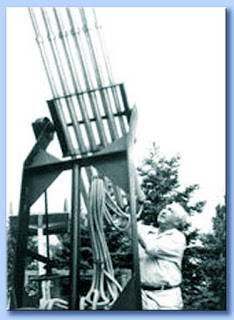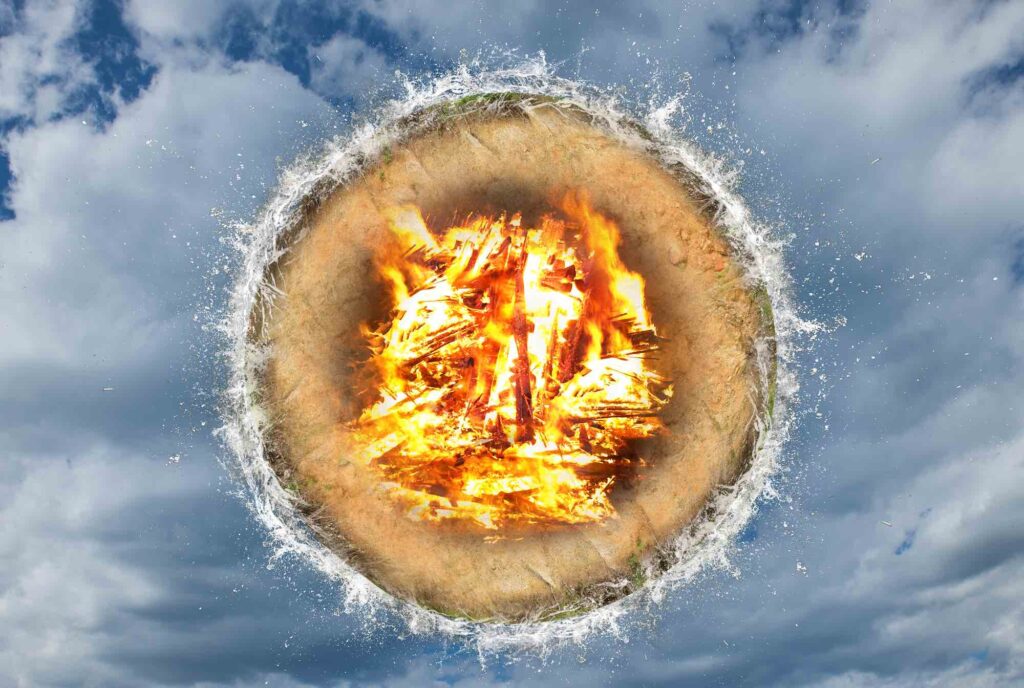La storia delle forze primordiali risale ai tempi antichi. I filosofi Greci parlavano dei quattro elementi, fuoco, acqua, aria e terra, di cui avevano conoscenza già da secoli. Possiamo trovare traccia di questa conoscenza nella medicina tradizionale cinese in cui vi è la presenza di quattro principali energie e negli Ayurveda indiani dove i principi fondamentali sono i tre dosha che sono la combinazione di due dei quattro elementi e il quinto elemento è chiamato Akash. Nella filosofia greca i quattro elementi classici erano visti come i pilastri di costruzione dell’universo e si credeva avessero sia qualità fisiche che metafisiche.
La terra era associata alla stabilità e al radicamento. Si pensava fosse il fondamento di tutte le cose, poiché forniva supporto e struttura necessaria alla vita. Era anche vista come elemento di fertilità e crescita, giacché nutriva piante e raccolti.
L’acqua era abbinata alla fluidità e al cambiamento. Si credeva fosse la fonte della vita stessa, poiché procurava l’umidità necessaria per la crescita e il nutrimento. L’acqua era anche conosciuta come l’elemento delle emozioni e dell’intuizione, visto che si riteneva fosse strettamente connessa con il regno dell’inconscio.
L’aria era connessa al movimento e ala mutevolezza. Si riteneva fosse l’elemento della comunicazione e dell’intelletto, poiché conteneva pensiero e suono. L’aria era vista anche come principio di libertà e di ispirazione, poiché permetteva l’esplorazione e l’innovazione.
Il fuoco era correlato all’energia e alla trasformazione. Si reputava essere il fattore della creatività e della passione, in quanto procurava la scintilla necessaria per la crescita e il cambiamento. Esso era anche considerato l’elemento della purificazione e della distruzione, giacché poteva contemporaneamente purificare e consumare.
Nella medicina cinese, la teoria dei cinque elementi viene utilizzata per comprendere le relazioni tra differenti aspetti del corpo, della mente e dello spirito. I cinque elementi sono legno, fuoco, aria, terra, metallo e acqua. Ciascun elemento ha proprie caratteristiche e associazioni, e si ritiene che corrisponda a vari organi, emozioni, colori, stagioni a sapori. Ad esempio, il legno è associato al fegato e alla bile, l’emozione della rabbia, il colore verde, la stagione della primavera e il sapore aspro.
Nella medicina ayurvedica i cinque elementi sono l’etere, l’aria, il fuoco, l’acqua e la terra . Ad esempio l’etere è associato al senso dell’udito, all’emozione dello spazio, al gusto pungente e alla stagione del decadimento.
Nella medicina tibetana, la teoria dei cinque elementi è utilizzata per diagnosticare e trattare gli squilibri del corpo della mente e dello spirito. I cinque elementi sono lo spazio, l’aria, il fuoco, l’acqua e la terra. Si ipotizza che il metallo, lo spazio e l’etere siano tutti interconnessi e sarebbero da ritenersi un unico elemento.
Già i greci consideravano un quinto elemento, anche conosciuto come quintessenza o etere.Il concetto di quintessenza sorse dalla credenza che, mentre i quattro elementi costituiscono il mondo fisico, questi stessi quattro elementi erano ritenuti responsabili di tutte le qualità della materia. Ad ogni buon conto, si pensava inoltre che doveva esserci qualcosa al di là dei quattro elementi che spiegasse il movimento e il comportamento dei corpi pesanti.
La quintessenza era ritenuta la sostanza che informa l’universo al di là del regno terracqueo. Veniva considerata eterna, immutabile e perfetta, ed era associata al divino e allo spirituale. Si credeva fosse la sostanza che costituiva le stelle e i pianeti, e che fosse responsabile dei loro movimenti e delle loro orbite.Nella medicina ayurvedica i cinque elementi sono l’etere o Akasha è altresì considerato il più sottile degli elementi ed è associato al suono e al senso dell’udito. Lo si reputa lo spazio che permette agli altri elementi di esistere.
Attualmente non vi è alcuna letteratura attendibile riguardo a tale argomento, eccetto il libro di Guenther Wachsmuth: Le eteriche forze formative del cosmo, la terra e l’uomo; un percorso di ricerca nel mondo del vivente, trovato solamente nella scuola di Rudolph Steiner. Crediamo che questo tipo di conoscenza sia insostituibile e che possa essere utile in qualsiasi aspetto dell’esistenza, dalla tecnologia alla medicina, dall’agricoltura, e molto altro.
La rabdomanzia è una tecnica che è in qualche modo collegata alla percezione di campi energetici sconosciuti, e i rabdomanti hanno sempre avvertito le forze eteriche da secoli.
Comunque, paragonando questa ricerca alla scienza del mainstream è praticamente una sfida, giacché le energie eteriche hanno un comportamento differente dall’elettromagnetismo classico, e non esiste un rilevatore adatto. Se questi campi energetici sconosciuti sono connessi in qualche modo con le energie primordiali, sarebbe un importante punto di svolta nella comprensione di ciò che percepiscono i rabdomanti, che migliorando le loro tecniche e i loro risultati potrebbero presentare una propria tecnologia.
Riteniamo che attualmente la fisica classica descriva solo basilarmente alcune manifestazioni di tali elementi primitivi come le particelle atomiche, campi elettrici, calore e luce. Alcuni hanno tentato di rappresentare visioni alternative rispetto alla scienza di sistema, da Wilhelm Reich a Nikola Tesla, e da T. S. Moray a Eugene Podkletnov, ma da questo punto di vista, nessuno è riuscito a fornire una spiegazione chiara e completa in grado di esaudire appieno la comprensione dei fenomeni ricercati.
The history of primordial forces dates back to ancient times. Greek philosophers spoke of the four elements, Fire, Water, Air, and Earth, which may have been an ancient knowledge already present for centuries. We can find sign of this knowledge in Chinese traditional medicine where we have five primordial forces and in Indian Ayurveda, where the basic principles are the 3 dosha, which are a combination of 2 of the 4 elements, and the fifth element called Akash. In Greek philosophy, the four classical elements were seen as the building blocks of the universe and were believed to have both physical and metaphysical qualities.
Earth was associated with stability and rooting. It was believed to be the foundation of all things, providing the support and structure necessary for life. It was also seen as the element of fertility and growth, as it nourished plants and crops.
Water was associated with fluidity and change. It was believed to be the source of all life, as it provided the moisture necessary for growth and nourishment. Water was also seen as the element of emotions and intuition, as it was believed to be closely connected to the realm of the unconscious.
Air was associated with movement and changeability. It was believed to be the element of communication and intellect, as it carried sound and thought. Air was also seen as the element of freedom and inspiration, as it allowed for exploration and innovation.
Fire was associated with energy and transformation. It was believed to be the element of creativity and passion, as it provided the spark necessary for growth and change. Fire was also seen as the element of purification and destruction, as it could both purify and consume.
In Chinese medicine, the five elements theory is used to understand the relationships between different aspects of the body, mind, and spirit. The five elements are wood, fire, earth, metal, and water. Each element has its own characteristics and associations, and is believed to correspond to different organs, emotions, colors, seasons, and tastes. For example, wood is associated with the liver and gallbladder, the emotion of anger, the color green, the season of spring, and the sour taste.
In Indian Ayurvedic medicine the five elements are ether, air, fire, water, and earth. For example, ether is associated with the sense of hearing, the emotion of space, the taste of pungent, and the season of fall.
In Tibetan medicine, the five elements theory is used to diagnose and treat imbalances in the body, mind, and spirit. The five elements are space, air, fire, water, and earth. It is a hypothesis that metal, space, and ether are all interconnected and could be considered as one element.
The Greeks already considered a fifth element, also known as quintessence or aether. The concept of quintessence arose from the belief that while the four basic elements made up the physical world, these four elements were also believed to be responsible for all of the properties and qualities of matter. However, it was also thought that there must be something beyond these four elements that explained the movement and behavior of the heavenly bodies.
Quintessence was believed to be the substance that filled the universe beyond the earthly realm. It was considered to be eternal, unchanging, and perfect, and was associated with the divine and the spiritual. It was thought to be the substance that made up the stars and planets, and was responsible for their movements and orbits.In Indian Ayurvedic medicine, Ether, or “akasha,” is also considered to be the most subtle of the elements and is associated with sound and the sense of hearing. It is believed to be the space that allows all other elements to exist.
Currently, there is no serious scientific literature on this topic, except for a book by Guenther Wachsmuth: The Etheric Formative Forces in Cosmos, Earth and Man; a Path of Investigation Into the World of the Living, found only in Rudolph Steiner’s school. We believe that this knowledge is valuable and can be useful in many aspects of life, from technology to medicine, agriculture to architecture, and more.
Dowsing is a technique that is somewhat correlated with feeling unknown energy fields, and dowsers have been feeling etheric forces for centuries.
However, connecting this research to mainstream science is quite challenging, as etheric forces behave differently from classic electromagnetism, and no suitable detector exists.If these unknown energy fields are somehow connected to primordial forces, it would be a significant breakthrough in understanding what dowsers feel, improve their technique and outcomes, and present technology.
We also believe that present-day mainstream physics basically describes some manifestations of these primitive elements as subatomic particles, electric fields, heat, and light. Many have attempted to provide alternative views from mainstream science, from Wilhelm Reich to Nikola Tesla, T. S. Moray to Eugene Podkletnov, but from this point of view, no one has succeeded in providing a clear and complete explanation capable of promoting full understanding of the phenomena they investigated.

Crediamo che Wilhelm Reich si sia avvicinato a riscoprire le forze eteriche tramite il suo lavoro sull’orgone accumulatore e lo spazzanuvole. Per comprendere a fondo questo concetto, si deve prendere in considerazione la struttura delle energie eteriche, in particolare in comparazione con le idee di Guenther Wachsmuth sulle dotazioni terrestri. L’Orgone può essere visto come un concentrato o stato alterato di uno specifico bilanciamento delle quattro forze.
We believe that Wilhelm Reich came close to rediscovering etheric forces through his work with the orgone accumulator and the cloudbuster. To fully understand these concepts, one must consider the framework of etheric forces, particularly in comparison to Guenther Wachsmuth’s ideas of earth envelopes. Orgone can be viewed as a concentrated or excited state of a specific balance of the four forces.

Natura e causa della rotazione terrestre
In questa struttura, le forze anti-biologiche come le radiazioni nucleari, le microonde e i raggi laser, ecc. possono essere considerate come manifestazioni dello squilibrio o della corruzione di forze eteriche biologiche. Si ritiene che le forze eteriche siano particelle subatomiche con masse variabili, che vanno dal fuoco (la più sottile) alla terra (la più pesante), come descritto nel libro Chimica occulta di Leadbeater e Besant.
Se le energie eteriche sono veramente particelle subatomiche, potrebbero diventare instabili nel raggruppare più sub-particelle positive o negative / ad esempio: trasformandosi da troppo Ying in troppo Yang), a quel punto tutta la tecnologia contraria alla vita si potrebbe mutare in favorevole alla vita stessa. Questa visione offre anche una nuova prospettiva della fisica reale.
Traduzione di Rosa Felicita
In this framework, non-life-supporting forces such as nuclear radiation, microwaves, and laser light an others can be seen as manifestations of the imbalance or corruption of the etheric life-supporting forces. The etheric forces are believed to be subatomic particles with varying masses, ranging from Fire (the most subtle) to Earth (the grossest), as described in the book Occult Chemistry by Leadbeater and Besant.
If etheric forces are really subatomic particles, they could become unsteady by having more positive or negative sub-particles (i.e., becoming too Yin or too Yang), then all technology that is adverse to life can be transformed into life-supporting. This insight offers also a new perspective on real physics.
bspace864



